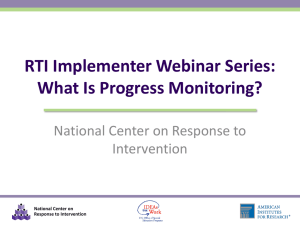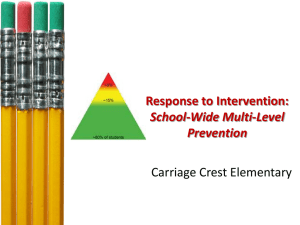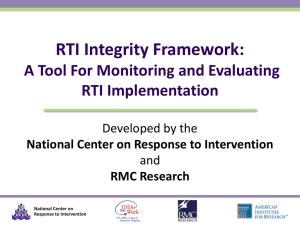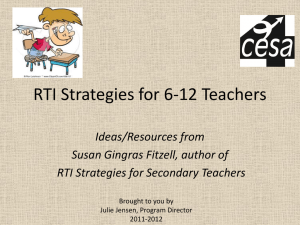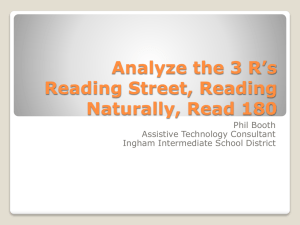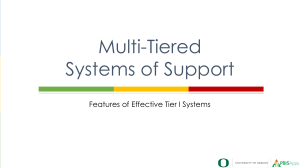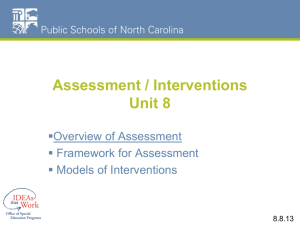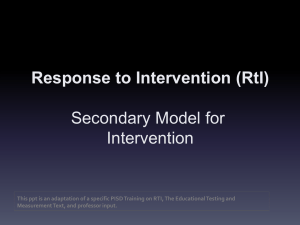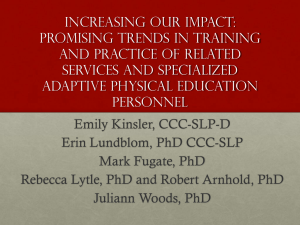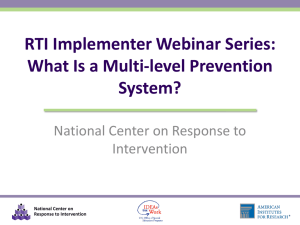PowerPoint Slides - National Center on Response to Intervention
advertisement
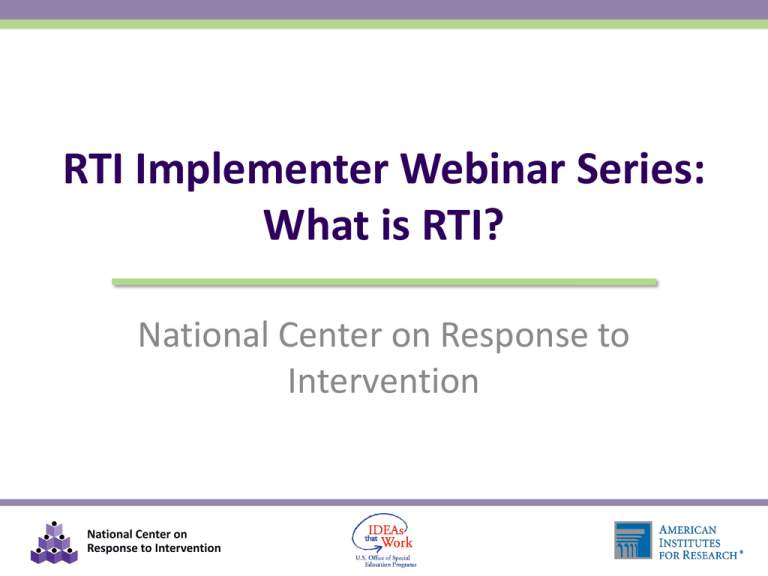
RTI Implementer Webinar Series: What is RTI? National Center on Response to Intervention National Center on Response to Intervention RTI Implementer Series Overview Introduction Screening Progress Monitoring Multi-level Prevention System Defining the Essential Components What Is RTI? What Is Screening? What Is Progress Monitoring? What Is a Multilevel Prevention System? Assessment and Data-based Decision Making Understanding Types of Assessment within an RTI Framework Using Screening Data for Decision Making Using Progress Monitoring Data for Decision Making IDEA and Multilevel Prevention System Establishing Processes Implementing RTI Establishing a Screening Process National Center on Response to Intervention Selecting Evidence-based Practices 2 Upon Completion Participants Will Be Able To: Understand how RTI is defined by the National Center on Response to Intervention Articulate the four essential components of RTI • Screening • Progress Monitoring • Multi-level Prevention System • Data-based Decision Making Recognize considerations for implementing RTI National Center on Response to Intervention 3 Vocabulary Handout Word Prediction Final Meaning Primary prevention level The bottom of the pyramid that represents instruction given to students without learning problems Instruction delivered to all students using research-based curricula and differentiation in the general education classroom. Incorporates universal screening, continuous progress monitoring, and outcome measures or summative assessments. National Center on Response to Intervention Picture/Sketch/Example Primary prevention 4 Why RTI? Sustained improvements in academic performance Decreased expulsion, behavioral referral, and suspension rates Decreased inappropriate special education referral and placement rates National Center on Response to Intervention 5 Defining RTI Response to intervention (RTI) integrates assessment and intervention within a school-wide, multi-level prevention system to maximize student achievement and reduce behavior problems. (National Center on Response to Intervention) National Center on Response to Intervention 6 Defining RTI With RTI, schools identify students at risk for poor learning outcomes, monitor student progress, provide evidence-based interventions and adjust the intensity and nature of those interventions based on a student’s responsiveness, and RTI may be used as part of the determination process for identifying students with specific learning disabilities or other disabilities. (National Center on Response to Intervention) National Center on Response to Intervention 7 Essential Components of RTI Screening Progress Monitoring School-wide, Multi-Level Prevention System • Primary Level • Secondary Level • Tertiary Level Data-Based Decision Making for: • Instruction • Evaluating effectiveness • Movement within the multi-level system • Disability identification (in accordance with state law) National Center on Response to Intervention 8 Essential Components of RTI National Center on Response to Intervention 9 Essential Component SCREENING National Center on Response to Intervention 10 Screening PURPOSE: Identify students who are at risk for poor learning outcomes FOCUS: ALL students TOOLS: Brief assessments that are valid, reliable, and demonstrate diagnostic accuracy for predicting learning or behavioral problems TIMEFRAME: Administered more than one time per year (e.g., fall, winter, spring) National Center on Response to Intervention 11 NCRTI Screening Tools Chart National Center on Response to Intervention www.rti4success.org 12 Essential Component PROGRESS MONITORING National Center on Response to Intervention 13 Progress Monitoring PURPOSE: Monitor students’ response to primary, secondary, or tertiary instruction in order to estimate rates of improvement, identify students who are not demonstrating adequate progress, and compare the efficacy of different forms of instruction FOCUS: Students identified through screening as at risk for poor learning outcomes TOOLS: Brief assessments that are valid, reliable, and evidence based TIMEFRAME: Students are assessed at regular intervals (e.g., weekly, biweekly, or monthly) National Center on Response to Intervention 14 NCRTI Progress Monitoring Tools Chart National Center on Response to Intervention www.rti4success.org 15 Essential Component SCHOOL-WIDE, MULTI-LEVEL PREVENTION SYSTEM National Center on Response to Intervention 16 Multi-Level Prevention System Tertiary Level of Prevention (~ 5 % of students) Secondary Level of Prevention (~15% of students) Primary Level of Prevention (~80% of students) National Center on Response to Intervention 17 Primary Level FOCUS: ALL students INSTRUCTION: District curriculum and instructional practices that are research based; aligned with state or district standards; and incorporate differentiated instruction SETTING: General education classroom ASSESSMENTS: Screening, continuous progress monitoring, and outcome measures or summative assessments National Center on Response to Intervention 18 Secondary Level FOCUS: Students identified through screening as at risk for poor learning outcomes INSTRUCTION: Targeted, supplemental instruction delivered to small groups SETTING: General education classroom or other general education location within the school ASSESSMENTS: Progress monitoring, diagnostic National Center on Response to Intervention 19 Tertiary Level FOCUS: Students who have not responded to primary or secondary level prevention INSTRUCTION: Intensive, supplemental instruction delivered to small groups or individually SETTING: General education classroom or other general education location within the school ASSESSMENTS: Progress monitoring, diagnostic Note: In some RTI models, tertiary instruction is special education. National Center on Response to Intervention 20 Changing the Intensity and Nature of Instruction Intervention Duration Frequency Interventionist Group size National Center on Response to Intervention 21 NCRTI Instructional Intervention Tools Chart National Center on Response to Intervention www.rti4success.org 22 Essential Component DATA-BASED DECISION MAKING National Center on Response to Intervention 23 Data-Based Decision Making: The Basics Analyze data at all levels of RTI implementation (e.g., state, district, school, grade level) and all levels of prevention (e.g., primary, secondary, or tertiary). Establish routines and procedures for making decisions. Set explicit decision rules for assessing student progress (e.g., state and district benchmarks, level, and/or rate). Use data to compare and contrast the adequacy of the core curriculum and the effectiveness of different instructional and behavioral strategies. National Center on Response to Intervention 24 Data-Based Decision Making: Types of Decisions Instruction Evaluate Effectiveness Movement within the multi-level prevention system Disability identification (in accordance with state law) National Center on Response to Intervention 25 Data-Based Decision Making: IDEA 2004 Learning Disability Eligibility To ensure that underachievement in a child suspected of having a specific learning disability is not due to lack of appropriate instruction in reading or math, the group must consider, as part of the evaluation described in 34 CFR 300.304 through 300.306: Data that demonstrate that prior to, or as a part of, the referral process, the child was provided appropriate instruction in regular education settings, delivered by qualified personnel; and Data-based documentation of repeated assessments of achievement at reasonable intervals, reflecting formal assessment of student progress during instruction, which was provided to the child’s parents. (www.idea.ed.gov) National Center on Response to Intervention 26 Essential Components of RTI National Center on Response to Intervention 27 Implementing the RTI Framework Select and implement evidence-based practices and procedures Implement essential components and identified framework with integrity Ensure that cultural, linguistic, and socioeconomic factors are reflected in the RTI framework and its components National Center on Response to Intervention 28 Need More Information? National Center on Response to Intervention www.rti4success.org RTI Action Network www.rtinetwork.org IDEA Partnership www.ideapartnership.org National Center on Response to Intervention 29 National Center on Response to Intervention This document was produced under U.S. Department of Education, Office of Special Education Programs Grant No. H326E07000.4 Grace Zamora Durán and Tina Diamond served as the OSEP project officers. The views expressed herein do not necessarily represent the positions or policies of the Department of Education. No official endorsement by the U.S. Department of Education of any product, commodity, service or enterprise mentioned in this publication is intended or should be inferred. This product is public domain. Authorization to reproduce it in whole or in part is granted. While permission to reprint this publication is not necessary, the citation should be: www.rti4success.org. National Center on Response to Intervention 30

